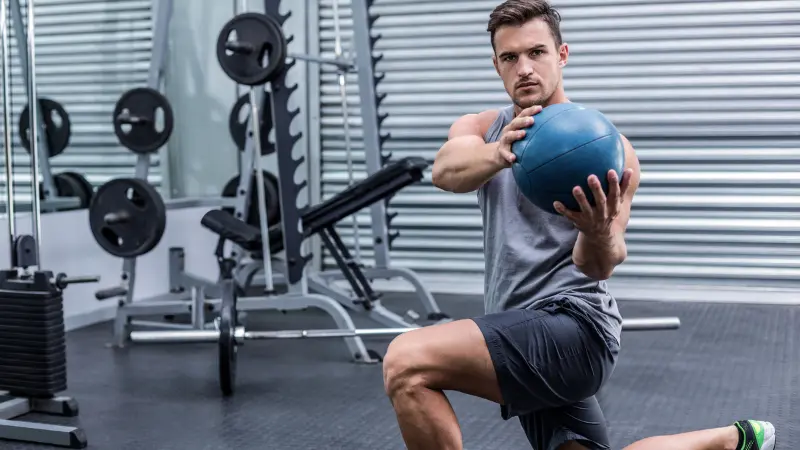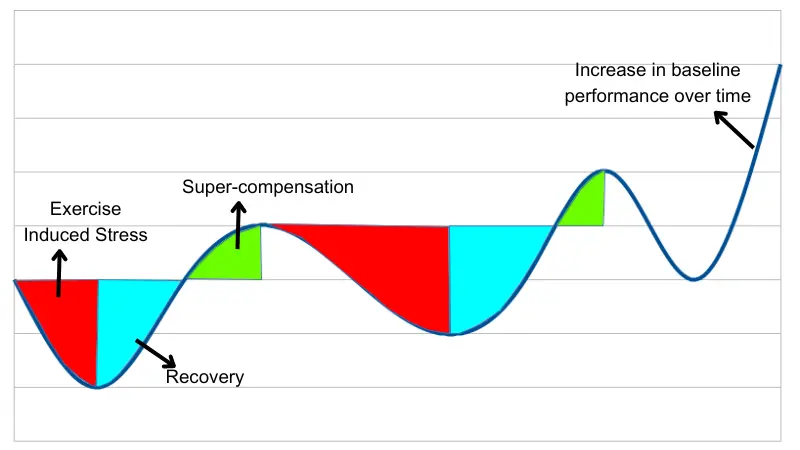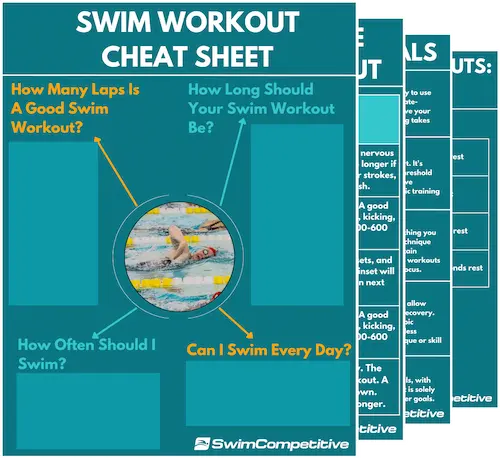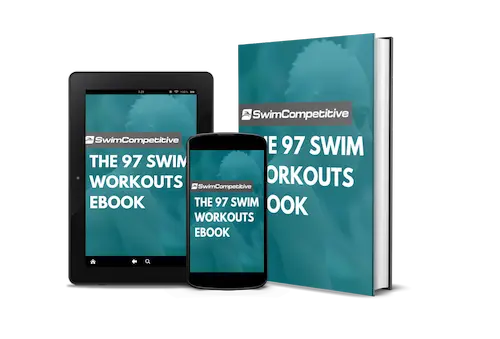If you want to become a better, faster, and more efficient swimmer, it’s critical to incorporate dryland exercises into your training regime.
Not only will you move better, be stronger, more powerful, and have increased endurance in the water, but you’ll also reduce your risk of injuries.
So if you want to gain a competitive advantage in the pool or just be the best swimmer you can be, consistent dryland training should be an integral part of your schedule.
Whether you are a competitive-, open water-, casual-, or masters swimmer, everyone can benefit from the physiological adaptations and benefits that dryland offers.
In this article, I share my knowledge and expertise from my years of dryland training experience and walk you through some of the best dryland exercises for swimmers. Whether you are a complete beginner or a seasoned pro, I’ll cover everything you need to know.
What is Dryland Training?
Dryland training refers to any training done outside the water to make you a better swimmer. This can include a variety of exercises and training styles ranging from mobility to weighted exercises and everything in between.
Conditioning exercises, such as rowing, cycling, or running, can also form part of your dryland training but should be incorporated cautiously and strategically. Swimming should be your primary form of conditioning, with dryland largely supplementing your training in terms of strength, power, and mobility work.

The Benefits of Dryland for Swimmers
Dryland training has various benefits for swimmers of all levels and ages. Here is a quick overview:
- Injury prevention: prevents injuries in the water by increasing muscle strength and mobility.
- Better swimming technique: improved mobility and proprioception allows you to move better, which ensures better swimming technique and efficiency in the water.
- More power: increased power allows you to move faster off the blocks and turns, and with each stroke and kick. More power also means you can swim faster for longer.
- Increased endurance: strength training can increase the number of type IIa muscle fibers you have, allowing for increased muscular endurance. Dryland conditioning can also help with aerobic and anaerobic fitness.
- Core strength: a strong core is one of the most critical parts of being a good swimmer. It connects your upper and lower body to transfer force when swimming and helps you maintain tension which is important for a rigid body position in the water.
- Stronger bones: resistance training has been shown to trigger osteoblasts (bone-forming cells) to create new bone. This is beneficial both for younger and older athletes populations alike.
- Training variety: dryland can be a good way to switch things up from being in the water all the time and adds variety to the training schedule of many swimmers.
- Increased confidence: being able to do 10-20+ pull-ups or squat a heavy load will give swimmers unmatched confidence during training and racing, knowing that their bodies are strong and capable.
These benefits come down to the main benefit of helping swimmers swim faster in the pool, which has been shown to be the case by various studies.
There is No Such Thing as The “Best” Exercises for Swimmers
Swimmers will often ask questions like what are the “best” exercises for swimming?
I hate to break it to you– but there is no single magical exercise (or set of exercises) that will miraculously turn you into a better swimmer.
Let me put it like this.
Different levels of swimmers should do different exercises.
And with level, I am referring to your experience with dryland training and your physical maturity.
The “best” exercises for a beginner to dryland training will look completely different than the “best” exercises for someone who has been following a structured dryland training program for years and has reached their full physical maturity.
So how do we address this?
Firstly, we can categorize all exercises under a few fundamental movement patterns. These include:
- Pushing: horizontal and vertical, single arm and double arm.
- Pulling: horizontal and vertical, single arm and double arm.
- Squatting: single leg and double leg.
- Hinging: single leg and double leg.
- Rotation: often refers to core exercises but can also include the hips and shoulders.
Your workout should include exercises from all 5 of these fundamental categories.
To help with your posture and reduce your risk of injury, consider including more pulling and hinging exercises than pushing and squatting exercises since these exercises will train your posterior chain, a series of muscles often underdeveloped in swimmers.
Secondly, you should perform a series of performance and mobility tests. This will allow you to determine if you are more on the beginner side or leaning toward the elite spectrum of dryland training.
These results will then allow you to use your judgment to select exercises from each movement category that are appropriate to the level of athlete that you are.
Pro Tip: Don’t get caught up in the age of a swimmer when selecting exercises. If a swimmer has shown to be competent in dryland training, then they should be able to progress to a higher level regardless of their age.
It’s also important to ensure that you are moving well and have decent mobility before ramping up the intensity.
For example, even if you are on the elite spectrum in terms of performance testing but lack in your mobility tests, you should take a step back and prioritize movement and mobility until it is sufficient. Otherwise, you are placing yourself at serious risk of injury, which can completely derail your training for months and even years.
Pro Tip: Be patient and conservative when it comes to dryland training. Take time to develop good mobility and a solid foundation of technique, movement, and strength. Your main priority should be your training in the pool. Dryland is simply a supplemental training aid to your in-water performance.
Dryland Exercises for Swimmers of Every Level
In this section, I break down some common exercises for each movement category and assign them to either beginner, intermediate, or advanced levels.
Since I will be covering a lot of exercises, I won’t go into depth on each. That said if you aren’t familiar with an exercise, a quick online search will be enough to find dozens of tutorials.
Pro tip: if you’re a more intermediate or advanced athlete, you can still use exercises from lower-level categories. These exercises can still be made challenging and effective by adjusting variables like their resistance and tempo. I use lower-level exercises in my own training programs all the time.
Pushing Exercises for Swimmers
Beginner pushing exercises for swimmers
- Knee push up
- Incline push up
- Dropdown push up
- Isometric push up hold
- Dumbbell floor press
- Cable overhead press
- One arm resistance band overhead press
- One-arm dumbbell overhead press
- Medicine ball chest throw
- Dumbbell push press
- Smith machine overhead press
- Cable tricep extension variations
Intermediate pushing exercises for swimmers
- Standard push up
- Decline push up
- Bodyweight dips
- Pike push up
- Resistance band push up
- Chest press (barbell/dumbbells)
- Barbell push press
- Overhead press (barbell/dumbbells)
- Wall-assisted handstand push up
Advanced pushing exercises for swimmers
- Renegade row push up with dumbbells
- TRX push up
- Weighted push ups
- Weighted dips
- Behind the neck barbell overhead press
- Handstand push up
Related: Upper body exercises for swimmers
Pulling Exercises for Swimmers
Beginner pulling exercises for swimmers
- Single-arm dumbbell/kettlebell row
- Dumbbell isometric row hold
- Medicine ball slams
- Band pull aparts
- Cable face pull
- TRX Row (the angle of your legs affects how easy or hard this exercise is)
- Australian pull ups
- Flexed arm hang
- Band assisted pull ups
- Dropdown pull ups
- Back extensions
- Lat pulldowns
- Banded rows
- Reverse dumbbell flys
- Bicep curl variations (dumbbell, cable, eazy bar)
Intermediate pulling exercises for swimmers
- Inverted TRX Row
- Machine rows
- Chin ups
- Pull ups
- Bent over barbell row
- Renegade row
- Dumbbell Pullover
Advanced pulling exercises for swimmers
- Chest chin up
- Chest pull up
- Weighted chin up
- Weighted pull up
- Archer pull ups
- Single-arm TRX row
Related: Arm exercises for swimmers
Squatting Exercises for Swimmers
Beginner squatting exercises for swimmers
- Bodyweight squat
- Jumping squats
- Bodyweight walking lunges
- Lunge jumps
- 180˚ Jumping squats
- Wall sits
- Split squat (dumbbells optional)
- Single leg sit down
- Bodyweight overhead squat
- Resistance band squat
- Mini-band squat
- Machine leg extensions
Intermediate squatting exercises for swimmers
- Dumbbell/ kettlebell goblet squats
- Single-arm kettlebell squat
- Stationary lunge with cable row
- Lateral squat (dumbbell/kettlebell optional)
- Single-leg step up (dumbbell/kettlebell optional)
- Rear-foot elevated split squats (dumbbells optional)
- Assisted single-leg squat
- Box jumps
- Alternating lunge jumps
- Depth jumps
- Sandbag/ dumbbell walking lunges
- Leg press
- Smith machine squat
- Barbell box squat
Advanced squatting exercises for swimmers (more?)
- Barbell back squat
- Dumbell / barbell front squat
- Zercher squat
- Rear-foot elevated barbell split squat
- Weighted jump squats with medicine ball/ kettlebell/ sandbag
- Overhead squat with dumbbells/ kettlebells/ sandbag/ barbell
- Single arm overhead squat with dumbbells/ kettlebells
- Overhead lunges with dumbbells/ kettlebells/sandbags/barbells
- Single-leg squat (dumbbells/ kettlebells optional)
- Elevated single-leg squat
Related: Leg exercises for swimmers
Hinging Exercises for Swimmers
Beginner hinging exercises for swimmers
- Bodyweight floor hip thrusts
- Bodyweight single leg floor hip thrust
- Bodyweight hip thrust with legs on a stability ball
- Bodyweight single-leg hip thrust with a leg on a stability ball
- Bodyweight hip thrust on a bench
- Single leg bodyweight hip thrust on a bench
- Banded x walk
- Mini band side steps
- Mini band hip abduction
- Bodyweight single-leg Romanian deadlift
- Cable single-leg Romanian deadlift
- PVC Deadlift
Intermediate hinging exercises for swimmers
- Trap bar deadlift
- Bodyweight single-leg hip thrust + hamstring curl on a stability ball
- Barbell hip thrusts on a bench
- Romanian deadlifts with barbell/ dumbbell
- Barbell deadlift
- Kettlebell swings
- Single-leg Romanian deadlift with dumbbells/ kettlebells
- Machine hamstring curl
Advanced hinging exercises for swimmers
- Single-leg Romanian deadlift with a barbell
- Single-arm Romanian deadlift with dumbbell/ kettlebell
- TRX Hamstring curl
- Single-leg TRX hamstring curl
- Single-arm kettlebell swings
Do You Want to Make Every Lap Count?
Stop wasting your time in the pool feeling lost and doing directionless swim workouts, and start training effectively! Our ebook contains 97 structured and goal-orientated swim workouts to help you become a better, faster, and fitter swimmer. Whether you’re a complete beginner or a seasoned pro, there are a multitude of workouts for every type of swimmer.
Core Exercises for Swimmers
Beginner core exercises for swimmers
- Bodyweight plank
- Bodyweight side plank
- Bodyweight plank on a stability ball with rotations
- Birddog with crunch
- Deadbug
- Toe touches
- Bicycle crunch
- Bodyweight Russian twist
- Medicine ball side throw
- Dropdown, straight leg, sit up
- Straight leg sit up
- Stability ball kneeling rollout
- Farmer’s carry with dumbbells/ kettlebells
- Banded pallof press
Intermediate core exercises for swimmers
- Hanging knee raise
- Deadbug with light dumbbells
- V-Ups
- Lying windshield wipers
- Russian twist with kettlebell/ medicine ball
- Mountain climbers
- Cable pallof press
- Plank with sandbag drag
- Straight leg sit up with dumbbell/ kettlebell
- Suitcase carry with dumbbell/ kettlebell
- Waiter carry with dumbbell/ kettlebell
- Half Turkish get up with kettlebell
- Kneeling ab wheel rollout with large wheel
Advanced core exercises for swimmers
- Hanging straight leg raise
- Alternating V-ups
- Stability ball jackknife
- Turkish get up
- Hanging windshield wipers
- Cross-carry with dumbbell/ kettlebell
- Kneeling ab wheel rollout with small wheel
- Standing ab wheel rollout
Related: Core exercises for swimmers
How to Progress to Higher Level Exercises for Swimmers
As you may have noticed, I have broken down the exercises for each foundational movement category into beginner, intermediate, and advanced levels. This may leave you with the question of how to progress these dryland exercises for swimmers to higher levels. In this section, I will explain how you can do that.
Step 1: Master the Foundational Exercise Technique
Whether you are starting with beginner exercises or more-advanced intermediate-level exercises, it’s important first to master the basic movement pattern of that exercise and ensure you are using good technique before trying to progress.
Step 2: Change Training Variables to Apply Progressive Overloading
Once you have mastered the foundational technique of an exercise, you can apply progressive overloading to it by changing the variables of the exercise or your training.
WebMD defines progressive overloading as: “gradually adding intensity when you’re strength training to improve your performance.”
This is important both for progressing to more complex exercises and ensuring you don’t plateau in your training.
A quick search online will reveal dozens of progressions that you can apply. Still, for the sake of simplicity, I will only be sharing those that I deem the most impactful and useful.

Variable 1: Ranges and Angles
The first way to apply progressive overloading is by changing the ranges and angles of the exercise you are trying to progress.
For example, start with an incline push up angled at 20 inches. After a few weeks, you lower the incline to 15 inches. Then to 10 inches, 5 inches, and so on until you can perform a normal flat push up.
Increasing the range through which an exercise is performed is another way to stimulate the muscle to become stronger. For example, for a single-leg Romanian deadlift, you can elevate yourself on a step, increasing the range through which the muscles have to work and forcing it to become stronger.
It’s also important to note that you should achieve a full range of motion when doing exercises and not doing half reps. (This is part of good exercise technique!)
Variable 2: Training Volume
By increasing your training volume, you are placing more stress on the muscle, forcing it to become stronger.
For example, in week 1, you might do 2 sets for all of your exercises; in weeks 2 and 3, you do 3 sets; and in weeks 4 to 6, you do 4 sets.
I generally don’t advise going over 4 sets. Remember, dryland is meant to supplement your swim training and help you swim faster. If you increase the volume too much, you’ll start running into recovery issues, and your swimming will suffer.
You can also increase the reps you do. Still, I generally advise limiting it to a maximum of 15 reps and only increasing reps on your more “supplementary” exercises and not your main strength exercises.
Generally, the main strength exercises are compound exercises that use multiple muscle groups at a time. Examples include pull ups, bench presses, deadlifts, weighted squats, etc.
I suggest rep limiting because strength is best trained in the >6 rep range. 8-12 Reps are ideal for building muscle, and 15+ reps are good for endurance. During your dryland training, your main focus should be increasing your strength and power.
For your main strength exercises, you can adjust the volume by increasing sets but not reps. You can further progress these movements using the other variables I have listed.
Variable 3: Exercise Tempo
One of my favorite variable changes is exercise tempo.
Often, I’ll see guys in the gym, using heavy weights but not having full control over the movement or only doing half of the range of motion.
This is bad technique. It will get you injured. Don’t do that.
During all exercises, your muscles will generally move through three contraction phases, namely the concentric, isometric, and eccentric phases. You can adjust the tempo of each or only one of these phases to make an exercise harder and become stronger.
If you are going to adjust tempo for only 1 phase at a time, start with the eccentric phase. This is where the muscle is activated most intensely and will yield the most benefit.
For example, for a bicep curl, you might curl the dumbbell up for 1 second (concentric), hold it for 1 second (isometric), and then lower the weight for 2 seconds. (eccentric). The next week you can increase the concentric phase to 2 seconds, then the isometric phase, and so on.
Variable 4: Resistance
One of the simplest and most effective variable changes you can make is by changing the resistance of an exercise.
For example, you might start by bench pressing only the 45 Lbs/ 20 kg bar. After mastering the technique, you add some weight. Now you’re bench pressing 65 Lbs/ 30 kgs. After another week or two, you increase the weight again, and so on.
You can do the same for exercises like a banded pull up, but in the reverse. You might start by using a 40 Ibs band, then lower it to 30 Ibs as you become stronger.
If you want to be advanced, you can also use relative resistance metrics such as RPE (rate of perceived exertion). In simple terms, an RPE is a 10-point scale of perceived exertion.
So if I assign you an RPE of 8, you should use a weight where you have 2 reps left in the tank.
With resistance, you have to, however, veer towards the conservative side to avoid injuries. Muscles and tissues like ligaments and tendons take time to adapt to resistance at different rates.
Make sure that your tissues have sufficient time to adapt. Remember, you don’t have to increase resistance every week or biweekly. There are other variables that you can change as well!
The National Academy of Sports Medicine advises athletes and coaches to adopt the Principle of Progression. It states: “Increases in time, weight or intensity should be kept within 10% or less each week to allow for a gradual adaptation while minimizing risk of injury.”
Step 3: Advancing to a Higher Exercise Level
Once you have mastered the exercise technique and adjusted training variables for a few weeks, you might feel strong enough and ready to progress to a higher exercise level.
If this is the case, go ahead.
Also, if you haven’t noticed, that is another form of progressive overloading.
It’s important to note that you might not necessarily have to go through all of the progressions before being strong enough to switch exercise levels.
At the same time, I advise you not to be too hasty with it. If you can be patient and take the time to work through all of the progressions, you will lay a strong foundation and avoid injuries.
Also, if you switch to a higher level and feel like it’s too much, don’t be afraid to regress to a lower level and spend a few more weeks (or months) working through the various variable adjustments until you feel comfortable enough to progress to a more advanced exercise.
How to Warm Up for Dryland Training
Before doing any exercise, whether in the pool or on land, you should always do an extensive warmup. This helps to increase blood flow, body temperature, and flexibility, which primes your muscles to perform and reduces your risk of injury. It also mentally prepares you for your workout.
A warmup should consist of a combination of activation and mobility work.
The activation portion is intended to increase your heart rate and body temperature, preparing your body to perform.
This can include light cardio or dynamic movements like rowing, spinning, skipping, bear crawls, lunges, knee drills, etc. You can also include some banded exercises here.
The mobility portion of your workout is intended to open up your body and increase your range of motion. This can include dynamic stretches and foam rolling.
How Many Days a Week Should Swimmers Do Dryland?
As a general rule of thumb, swimmers should do 2 to 3 full body dryland workouts per week. This is adequate to build strength and power while allowing enough recovery to ensure you aren’t hindering your performance in the water.
A meta-analysis of 10 studies published in the Journal of Sports Medicine has shown that 2 days per week is the minimum training frequency required for muscle hypertrophy and strength.
I recommend doing at least 3 workouts per week. If you have a busy week, you can switch it to 2 workouts, which will ensure you maintain the progress you’ve made thus far in your training.
Should you do Dryland Before or After Swimming?
If your schedule allows for it, the ideal scenario is that you do a workout, rest for a few hours, and then do your second workout. In this case, it doesn’t matter very much whether you do dryland or swim first, and it is mostly up to your schedule and personal preference.
However, I recommend doing dryland first if you do back-to-back workouts. This allows your muscles to be warm and activated when you jump in the pool. It’s also easier to get injured during dryland training if you are fatigued from swimming beforehand compared to the other way around.
Remember, it’s still important to consider the intensity of your dryland workout, as it will affect your swimming.
If your dryland workout was intense, you should stick to a moderate-intensity swim workout or focus on technique. However, if the dryland intensity was low or moderate, you can increase the intensity of your swim.
It all comes back to recoverability.
If you decide to do dryland after swimming, it’s important to consider the same intensity guidelines.
Remember, it’s much easier to get injured during dryland training when you are already fatigued since you’ll be dealing with much more resistance than in the water. Therefore, adjusting your dryland training accordingly is important to avoid injuries.
Related: Should you lift weights before or after swimming?
How Should You Approach Dryland Before a Swim Meet or During Taper?
Many swimmers believe you should stop dryland training during taper or the days leading up to a swim meet.
This isn’t only wrong but detrimental to your swimming performance as well.
For general in-season meets, you can do dryland the day before. If there is a 24 to 48 hour recovery period, you don’t have to reduce the volume of your training session, but you can if you want to.
For general meets, I recommend dropping your training volume by 25%. This means if you usually do 4 sets, now you do 3.
For important, non-taper meets, you can drop volume by 50-75% for the workout or two before the meet. You can continue to train up until the day before the meet.
For taper meets, you should gradually decrease volume until you have reduced it by 75% the week of the meet. For example, if you do a 3-week taper, you might reduce the volume by 25% in the first week, 50% in the second week, and 75% in the third week.
Also, include plyometric exercises like box jumps in your training for 1-2 weeks before a taper meet. These should be exercises you have previously done, and your body is already familiar with.
Dryland Equipment Recommendations for Swimmers
Most gyms should have all the equipment you need to do your dryland training. That said, you might not have access to a gym or occasionally want to do a workout at home. Furthermore, there are a few specific pieces of dryland gear (certain resistance bands, for example) that most gyms won’t supply.
The table below shows the most important dryland equipment you need, whether you train at a gym or want to build your own home gym. That said, it’s still nice to have some basic gear at home for days when you can’t make it to the gym.
I suggest investing in some of the low-intermediate budget equipment to keep at home. You can use the rest of the gear at the gym. Unless, of course, you want to build a fully-equipped home gym and your budget allows for it.
If you want to know what equipment I recommend to start out with, I suggest investing in the following:
- Pull up bar
- A few dumbbells of various weights
- Resistance tubing bands (here are some resistance band exercises)
- Medicine ball
| Equipment | Need Requirement | Budget Level | Included with Gym | Buy on Amazon |
| Pull up bar | Must have | Low to Intermediate | Yes | > View Price |
| Dumbbells | Must have | Intermediate to high | Yes | > View Price |
| Kettlebell | Must have | Low to high | Yes | > View Price |
| Superband | Optional | Low | Depends | > View Price |
| Mini band | Optional | Low | Depends | > View Price |
| Resistance tubing bands | Optional | Low | No | > View Price |
| Ab roller | Must have; intermediate/advanced athletes | Low | Depends | > View Price |
| Medicine Ball | Must have | Low | Yes | > View Price |
| Suspension System (TRX) | Optional | Low to Intermediate | Depends | > View Price |
| Stability ball | Optional | Low | Yes | > View Price |
| Sandbags | Optional | Intermediate | Yes | > View Price |
| Weighted Vest/ Weight Belt | Must have; intermediate/advanced athletes | Low to intermediate | Unlikely | > View Price |
| Olympic barbell and Weight Plates | Must have | Intermediate to High | Yes | > View Price |
| Bench | Must have | Low to Intermediate | Yes | > View Price |
| Power rack | Good-to-have | Intermediate to high | Yes | > View Price |
| Rowing machine | Nice-to-have | Intermediate to high | Yes | > View Price |
Pro Tip: Don’t limit your dryland training because you don’t want to spend some money on equipment. You don’t need a full home gym, but at least invest in a few pieces of equipment to enhance your training.
Swim Faster With These Dryland Exercises for Swimmers
Dryland training can be of phenomenal benefit to your swimming and will not only allow you to swim faster but will also make you a more well-rounded athlete in and out of the water. Not to mention that it can help greatly reduce your risk of injuries.
Pick some dryland exercises that you like and are appropriate to your level to start with. Then apply progressive overloading to become stronger over time. Also, ensure that you follow all the other best practices and guidelines discussed in this article to achieve the best results.
Train hard!





